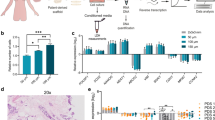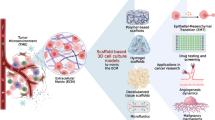Abstract
Accumulating experimental evidence suggests that 3D in vitro cancer models strengthen our understanding of vital processes in the tumor microenvironment (TME) and accelerate the drug discovery pipeline. Previous studies examining the effects of specific miRNAs on cancer cells in vitro have involved ectopic expression of miRNA mimics in 2D in vitro culture. Assessment of cell viability and gene expression ensures that upregulation of the chosen miRNA and repression of its target genes have been achieved. However, this 2D culture is overly simplified and lacks the complex cell to extracellular matrix (ECM) interactions observed in the native TME, yielding results often not reproduced when progressed to in vivo studies. Hence, this chapter describes a novel method of overexpressing the miRNA mimic in cells cultured on 3D collagen-based scaffolds adapted from tissue engineering techniques. Cell growth on scaffolds is sequentially monitored via a DNA quantification assay, and overexpression of the miRNA mimic and repression of its target gene is assessed via reverse transcription quantitative PCR (RT-qPCR).
Access this chapter
Tax calculation will be finalised at checkout
Purchases are for personal use only
Similar content being viewed by others
References
O’Brien J, Hayder H, Zayed Y, Peng C (2018) Overview of microRNA biogenesis, mechanisms of actions, and circulation. Front Endocrinol (Lausanne) 9:402. https://doi.org/10.3389/FENDO.2018.00402
Ha M, Kim VN (2014) Regulation of microRNA biogenesis. Nat Rev Mol Cell Biol 158(15):509–524. https://doi.org/10.1038/nrm3838
de Rie D, Abugessaisa I, Alam T et al (2017) An integrated expression atlas of miRNAs and their promoters in human and mouse. Nat Biotechnol 359(35):872–878. https://doi.org/10.1038/nbt.3947
Urbich C, Kuehbacher A, Dimmeler S (2008) Role of microRNAs in vascular diseases, inflammation, and angiogenesis. Cardiovasc Res 79:581–588. https://doi.org/10.1093/CVR/CVN156
Lin S, Gregory RI (2015) MicroRNA biogenesis pathways in cancer. Nat Rev Cancer 156(15):321–333. https://doi.org/10.1038/nrc3932
Romaine S, Tomaszewski M, Condorelli G, Samani N (2015) MicroRNAs in cardiovascular disease: an introduction for clinicians. Heart 101:921–928. https://doi.org/10.1136/HEARTJNL-2013-305402
Pua H, Ansel K (2015) MicroRNA regulation of allergic inflammation and asthma. Curr Opin Immunol 36:101–108. https://doi.org/10.1016/J.COI.2015.07.006
Issler O, Chen A (2015) Determining the role of microRNAs in psychiatric disorders. Nat Rev Neurosci 16:201–212. https://doi.org/10.1038/NRN3879
Rupaimoole R, Slack FJ (2017) MicroRNA therapeutics: towards a new era for the management of cancer and other diseases. Nat Rev Drug Discov 163(16):203–222. https://doi.org/10.1038/nrd.2016.246
Kim TK, Eberwine JH (2010) Mammalian cell transfection: the present and the future. Anal Bioanal Chem 397:3173. https://doi.org/10.1007/S00216-010-3821-6
Wan X, Zhang Y, Lan M et al (2018) Meiotic arrest and spindle defects are associated with altered KIF11 expression in porcine oocytes. Environ Mol Mutagen 59:805–812. https://doi.org/10.1002/EM.22213
Nolan J, Stallings RL, Piskereva O (2017) Assessment of basic biological functions exerted by miRNAs. Methods Mol Biol 1509:11–16. https://doi.org/10.1007/978-1-4939-6524-3_2
Nolan JC, Frawley T, Tighe J et al (2020) Preclinical models for neuroblastoma: advances and challenges. Cancer Lett 474:53–62. https://doi.org/10.1016/J.CANLET.2020.01.015
Costard LS, Hosn RR, Ramanayake H et al (2021) Influences of the 3D microenvironment on cancer cell behaviour and treatment responsiveness: a recent update on lung, breast and prostate cancer models. Acta Biomater. https://doi.org/10.1016/j.actbio.2021.01.023
Gallagher C, Murphy C, O’Brien FJ, Piskareva O (2021) Three-dimensional in vitro biomimetic model of Neuroblastoma using collagen-based scaffolds. J Vis Exp:e62627. https://doi.org/10.3791/62627
Curtin C, Nolan JC, Conlon R et al (2018) A physiologically relevant 3D collagen-based scaffold–neuroblastoma cell system exhibits chemosensitivity similar to orthotopic xenograft models. Acta Biomater 70:84–97. https://doi.org/10.1016/j.actbio.2018.02.004
Ouellette JN, Drifka CR, Pointer KB et al (2021) Navigating the collagen jungle: the biomedical potential of fiber organization in cancer. Bioengineering 8:1–19
Lowe B, Hardy JG, Walsh LJ (2020) Optimizing Nanohydroxyapatite nanocomposites for bone tissue engineering. ACS Omega 5:1–9
Curtin CM, Cunniffe GM, Lyons FG et al (2012) Innovative collagen nano-hydroxyapatite scaffolds offer a highly efficient non-viral gene delivery platform for stem cell-mediated bone formation. Adv Mater 24:749–754. https://doi.org/10.1002/adma.201103828
O’Brien FJ, Harley BA, Yannas IV, Gibson L (2004) Influence of freezing rate on pore structure in freeze-dried collagen-GAG scaffolds. Biomaterials 25:1077–1086. https://doi.org/10.1016/S0142-9612(03)00630-6
Haugh MG, Jaasma MJ, O’Brien FJ (2009) The effect of dehydrothermal treatment on the mechanical and structural properties of collagen-GAG scaffolds. J Biomed Mater Res A 89:363–369. https://doi.org/10.1002/jbm.a.31955
O’Brien FJ, Harley BA, Yannas IV, Gibson LJ (2005) The effect of pore size on cell adhesion in collagen-GAG scaffolds. Biomaterials 26:433–441. https://doi.org/10.1016/j.biomaterials.2004.02.052
Murphy CM, Haugh MG, O’Brien FJ (2010) The effect of mean pore size on cell attachment, proliferation and migration in collagen-glycosaminoglycan scaffolds for bone tissue engineering. Biomaterials 31:461–466. https://doi.org/10.1016/j.biomaterials.2009.09.063
Cunniffe GM, Dickson GR, Partap S et al (2010) Development and characterisation of a collagen nano-hydroxyapatite composite scaffold for bone tissue engineering. J Mater Sci Mater Med 21:2293–2298. https://doi.org/10.1007/s10856-009-3964-1
Haugh MG, Murphy CM, McKiernan RC et al (2011) Crosslinking and mechanical properties significantly influence cell attachment, proliferation, and migration within collagen glycosaminoglycan scaffolds. Tissue Eng Part A 17:1201–1208. https://doi.org/10.1089/ten.tea.2010.0590
Tierney CM, Haugh MG, Liedl J et al (2009) The effects of collagen concentration and crosslink density on the biological, structural and mechanical properties of collagen-GAG scaffolds for bone tissue engineering. J Mech Behav Biomed Mater 2:202–209. https://doi.org/10.1016/j.jmbbm.2008.08.007
Author information
Authors and Affiliations
Corresponding author
Editor information
Editors and Affiliations
Rights and permissions
Copyright information
© 2023 The Author(s), under exclusive license to Springer Science+Business Media, LLC, part of Springer Nature
About this protocol
Cite this protocol
Murphy, C., Gallagher, C., Piskareva, O. (2023). Evaluation of miRNA Expression in 3D In Vitro Scaffold-Based Cancer Models. In: Rani, S. (eds) MicroRNA Profiling. Methods in Molecular Biology, vol 2595. Humana, New York, NY. https://doi.org/10.1007/978-1-0716-2823-2_15
Download citation
DOI: https://doi.org/10.1007/978-1-0716-2823-2_15
Published:
Publisher Name: Humana, New York, NY
Print ISBN: 978-1-0716-2822-5
Online ISBN: 978-1-0716-2823-2
eBook Packages: Springer Protocols




